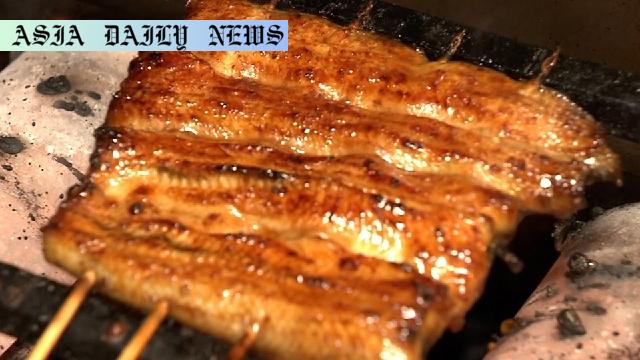eel: Japanese eel restaurants are busy this summer serving dishes believed to replenish stamina during hot weather.
Customers crowded Japanese eel restaurants to enjoy a traditional midsummer delicacy.
Eating eel is believed to help beat summer fatigue and boost stamina.
The Urawa district in Saitama City is renowned for its historic eel cuisine industry.
A 150-year-old restaurant continues to preserve its cooking method using grilled eel.
Eel dishes remain a symbol of luxury and indulgence in Japan’s summer meals.

The Historic Significance of Eel in Japanese Culture
Japan has an abundance of culinary traditions, and eating eel on Midsummer’s Day of the Ox stands out as one of the most flavorful and culturally significant. This practice has been followed for centuries, with the belief that consuming eel, or “unagi,” provides the necessary nutrients and stamina to beat the sweltering summer heat. Traditionally, Japan’s humid summers can leave people feeling drained, and specialty dishes like unagi are thought to provide an energizing boost, thanks to their rich protein and nutrient content.
The historical roots of this tradition are deeply tied to the regions known for their freshwater eel populations. Areas like Saitama’s Urawa district have forged a reputation as havens for exquisite eel dishes. Locals took advantage of the abundance provided by their marshy ecosystems, turning the art of eel preparation into a celebrated craft. Over time, unagi-centric cuisine became a landmark of traditional Japanese dining, especially during Japan’s notoriously hot summer months.
Urawa District: A Culinary Capital for Eel
Today, the Urawa district in Saitama City continues to thrive as a center of eel cuisine. Officially recognized as a traditional industry, the area is home to numerous establishments that have perfected the art of eel preparation. This craftsmanship is vividly illustrated by a 150-year-old restaurant in the Minami Ward of Saitama. Loyal customers and curious tourists alike are drawn to its time-tested cooking methods, which involve boiling and then expertly grilling the eel over charcoal.
What sets this establishment apart, however, is not just the method but also the unique sauce used in grilling eel. The sauce has been continuously replenished since the restaurant’s founding, imparting a rare depth of flavor that modern eateries struggle to emulate. The intoxicating aroma of grilled eel wafts through the district, enticing long queues of patrons seeking a meal that’s as traditional as it is indulgent.
The Culinary Experience: More than Just Food
Dining on unagi is about more than sustenance; it’s an experience that reflects luxury and close cultural connection. Many Japanese people, like the customer in the Minami Ward restaurant, treat eating eel as an occasional indulgence. A perfectly cooked eel meal can provide not only energy but also a sense of mental satisfaction amid the exhausting summer heat. Unagi dishes are known for their rich yet delicate flavor profile, with plump and tender meat that melts in the mouth. Served with sides of pickled vegetables and steamed rice, these meals symbolize a combination of health and refinement.
Meals like these tie individuals to Japan’s longstanding food traditions and communal values. Whether enjoyed with family, as the man in the story described, or as a moment of personal indulgence, unagi reflects a connection to both the past and the future.
Preserving the Tradition of Unagi
Despite its popularity, Japan faces challenges in sustaining its eel tradition. Overfishing and changing environmental conditions have placed strain on eel populations, raising the importance of sustainable practices in the industry. The President of the long-standing restaurant, Kojima Masayuki, expressed his commitment to ensuring that unagi remains synonymous with Japanese culinary identity. By collaborating with local industries and adapting to sustainability measures, restaurants like his aim to strike a balance between honoring the past and conserving for the future.
The essence of consuming unagi on Midsummer’s Day of the Ox lies beyond just the food. It represents an embrace of seasonal traditions, a respect for cultural heritage, and a reminder of the importance of balancing historical customs with modern challenges. With dedicated efforts, unagi will likely remain a beloved symbol of resilience and gastronomic excellence for generations to come.



Commentary
The Cultural Significance of Eel Traditions
Japan’s eel consumption tradition is more than just a culinary preference. It’s a fascinating example of how food and tradition are intricately connected. What I find most captivating is the symbolism of eel as a source of stamina and resilience during the scorching summer months. This is a brilliant demonstration of how food can serve not only as sustenance but as a cultural antidote to nature’s challenges, something we could all appreciate in an era of global climatic changes.
Community Connection through Cuisine
The story also highlights the role of food in community life. The bustling atmosphere of the Urawa district during Midsummer’s Day of the Ox paints a vivid picture of people coming together to celebrate their shared heritage. The 150-year-old restaurant serves as a testament to the enduring power of tradition and the dedication of individuals who keep these customs alive. It reminds me of how every bite of food carries a story—one of hard work, history, and local identity.
The Future of Traditional Cuisine
As we admire Japan’s commitment to preserving its eel tradition, it’s worth discussing the imperative of sustainability. Eel populations are under threat globally, and striking a balance between indulgence and conservation is crucial. I deeply respect how the restaurant’s president approaches this issue, ensuring future generations can continue to experience the unagi tradition. This practice gives us a model of mindful consumption that the global food industry can undoubtedly learn from.